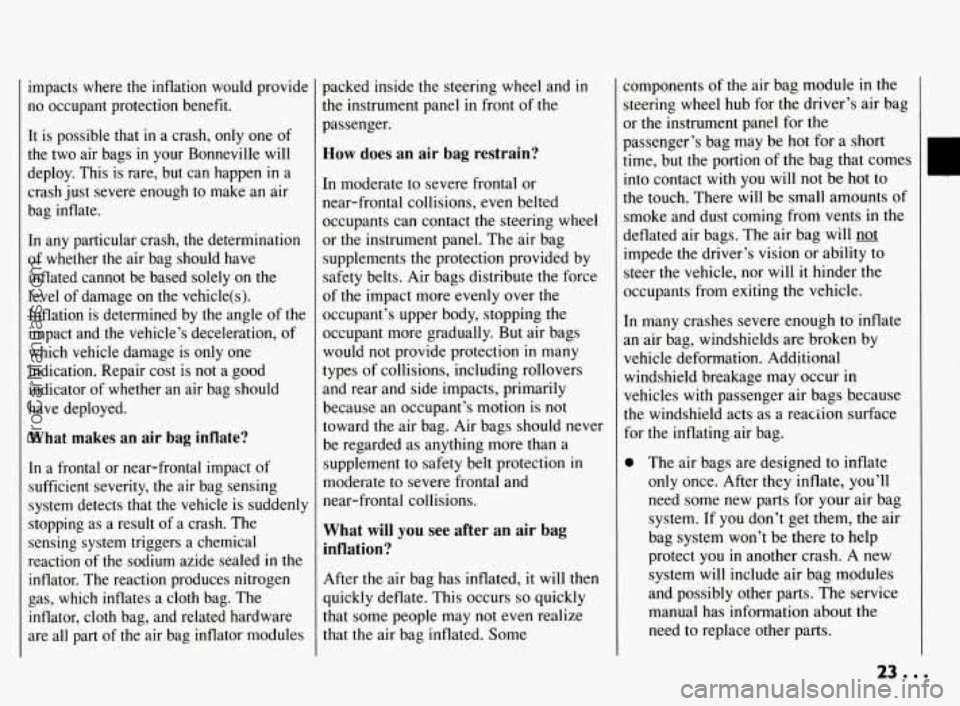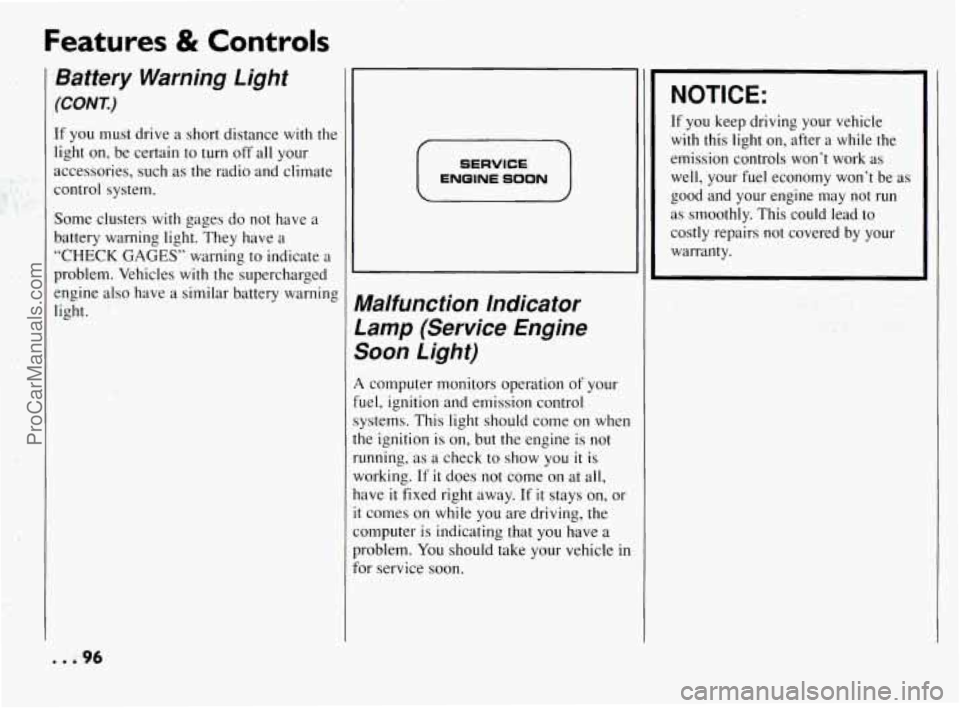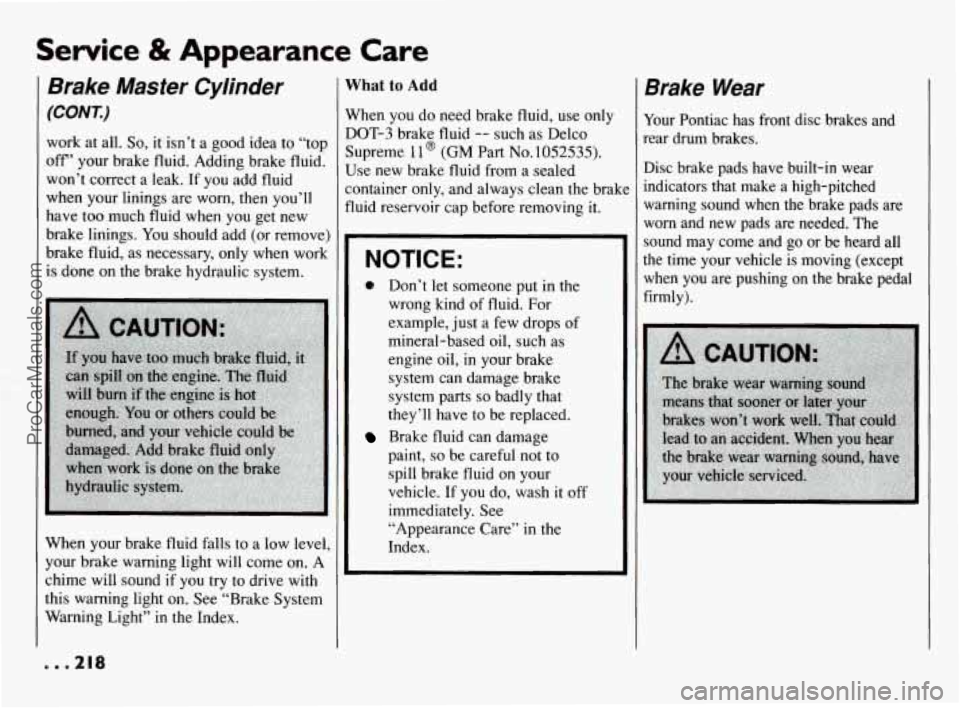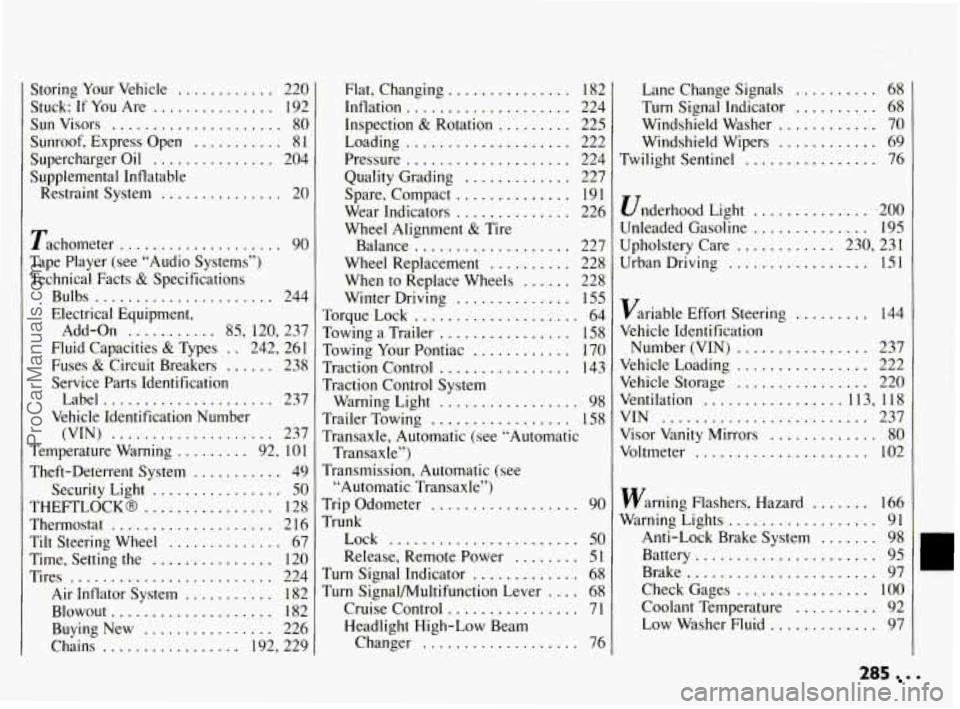1994 PONTIAC BONNEVILLE service indicator
[x] Cancel search: service indicatorPage 24 of 290

impacts where the inflation would provide
no occupant protection benefit.
It is possible that
in a crash, only one of
the two air bags in your Bonneville will
deploy. This is rare, but can happen
in a
crash just severe enough to make an air
bag inflate.
In any particular crash, the determination
of whether the air bag should have
inflated cannot be based solely on the
level
of damage on the vehicle(s).
Inflation is determined by the angle of the
impact and the vehicle’s deceleration, of
which vehicle damage is only one
indication. Repair cost is not a good
indicator of whether an air bag should
have deployed.
What makes an air bag inflate?
In a frontal or near-frontal impact of
sufficient severity, the air bag sensing
system detects that the vehicle
is suddenly
stopping as a result of a crash. The
sensing system triggers a chemical
reaction of the sodium azide sealed in the
inflator. The reaction produces nitrogen
gas, which inflates a cloth bag. The
inflator, cloth bag, and related hardware
are all part of the air bag inflator modules packed
inside the steering wheel and
in
the instrument panel in front of the
passenger.
How does an air bag restrain?
In moderate to severe frontal or
near-frontal collisions, even belted
occupants can contact the steering wheel or the instrument panel. The air bag
supplements the protection provided by
safety belts. Air bags distribute the force
of the impact more evenly over the
occupant’s upper body, stopping the
occupant more gradually. But air bags
would not provide protection in many
types of collisions, including rollovers
and rear and side impacts, primarily
because an occupant’s motion is not
toward the air bag. Air bags should never
be regarded as anything more than a
supplement to safety belt protection
in
moderate to severe frontal and
near-frontal collisions.
What will you see after an air bag
inflation?
After the air bag has inflated, it will then
quickly deflate. This occurs
so quickly
that some people may not even realize
that the air bag inflated. Some components of the
air bag module in the
steering wheel hub for the driver’s air bag
or the instrument panel for the
passenger’s bag may be hot for a short
time, but the portion of the bag that comes
into contact with you will not be hot to
the touch. There will be small amounts of
smoke and dust coming from vents in the
deflated air bags. The air bag will
not
impede the driver’s vision or ability to
steer the vehicle, nor will it hinder the
occupants from exiting the vehicle.
In many crashes severe enough to inflate
an air bag, windshields are broken by
vehicle deformation. Additional
windshield breakage may occur in
vehicles with passenger air bags because
the windshield acts as a reac’lion surface
for the inflating air bag.
The air bags are designed to inflate
only once. After they inflate, you’ll
need some new parts for your air bag
system. If you don’t get them, the air
bag system won’t be there to help
protect you in anpther crash.
A new
system will include air bag modules
and possibly other parts. The service
manual has information about the
need to replace other parts.
C
23...
ProCarManuals.com
Page 97 of 290

Features & Controls
Battery Warning Light
(CONT.)
If you must drive a short distance with the
light
on, be certain to turn off all your
accessories, such as
the radio and climate
control system.
Some clusters with gages do not have a
battery warning light. They have
a
“CHECK GAGES” warning to indicate a
problem. Vehicles with the supercharged
engine also have a similar battery warning
light.
SERVICE
ENGINE SOON
Malfunction Indicator
.amp (Service Engine
Soon Light)
1 computer monitors operation of your
uel, ignition and emission control
ystems. This light should come on when
he ignition is on, but the engine is not
unning, as a check
to show you it is
iorking. If
it does not come on at all,
ave
it fixed right away. If it stays on, or
: comes on while you are driving, the
omputer is indicating that you have
a
roblem. You should take your vehicle in
x- service soon.
NOTICE:
If you keep driving your vehicle
with this light on, after a while the
emission controls won’t work as
well,
your fuel economy won’t be as
good and your engine may not
run
as smoothly. This could lead to
costly repairs not covered by your
warranty.
... 96
ProCarManuals.com
Page 209 of 290

Service & Appearance Care
What Kind of Oil to Use
‘CONT.)
NOTICE:
If you use oils that do not have
either the “starburst” symbol or an
API SH or SG designation, you can
cause engine damage not covered
by
your warranty.
GM Goodwrench@ oil (in Canada, GM
Engine Oil) meets all the requirements fc
your vehicle.
Engine Oil Additives
I Don‘t add anything to your oil. Your
Pontiac dealer is ready
to advise if you
[hink something should be added.
When to Change Engine
Oil
See if any one of these is true for you:
0 Most trips are less than 4 miles
(6 km).
0 It’s below freezing outside and most
trips are less than
10 miles (16 km).
0 The engine is at low speed most of the
time (as
in door-to-door delivery, or
in stop-and-go traffic).
0 You tow a trailer often.
0 Most trips are through dusty places.
If any one of these is true for your
vehicle, then you need
to change your giJ
and filter every 3,000 miles (5 000 km) or
3 months -- whichever comes first. (See
“Change Oil Indicator”
in the Index.)
If none of them is true, change the oil
every
7,500 miles ( 12 500 km) or 12
months -- whichever comes first. Change
the filter at the first oil change and
at
every other oil change after that.
Engine Coolant Heater
(Engine Block Heater)
An engine coolant heater can be a big
help
if you have to park outside in very
cold weather,
0°F (-ISOC) or colder. If
your vehicle has this option, see “Engine
Coolant Heater”
in the Index.
What to Do with Used Oil
Did you know that used engine oil
contains certain elements that may be
unhealthy for your skin and could even
cause cancer‘? Don’t let used oil stay
on
your skin for very long. Clean your skin
and nails
with soap and water, or a good
hand cleaner. Wash or properly throw
away clothing or rags containing used
engine oil. (See the manufacturer’s warnings about the use and disposal of oil
products.)
. . .208
ProCarManuals.com
Page 219 of 290

Service & Appearance Care
Brake Master Cylinder
(CONK)
work at all. So, it isn’t a good idea to “top
off’ your brake fluid. Adding brake fluid.
won’t correct a leak. If you add fluid
when your linings are worn, then you’ll
have too much fluid when you get new
brake linings.
You should add (or remove)
brake fluid, as necessary, only when work
is done on the brake hydraulic system.
When your brake fluid falls to a low level,
your brake warning light will come on. A
chime will sound
if you try to drive with
this warning light on. See “Brake System
Warning Light” in the Index.
. . .218
What to Add
When you do need brake fluid, use only
DOT-3 brake fluid
-- such as Delco
Supreme 11
@ (GM Part No. 1052535).
Use new brake fluid from a sealed
container only, and always clean the brake
fluid reservoir cap before removing
it.
NOTICE:
e Don’t let someone put in the
wrong kind of fluid. For
example, just a few drops of
mineral-based oil, such as
engine oil, in your brake
system can damage brake
system parts
so badly that
they’ll have to be replaced.
Brake fluid can damage
paint,
so be careful not to
spill brake fluid on your
vehicle. If you do, wash it
off
immediately. See
“Appearance Care”
in the
Index.
Brake Wear
Your Pontiac has front disc brakes and
rear drum brakes.
Disc brake pads have built-in wear
indicators that make a high-pitched
warning sound when the brake pads are
worn and new pads are needed. The
sound may come and
go or be heard all
the time your vehicle is moving (except when you are pushing on the brake pedal
firmly).
ProCarManuals.com
Page 227 of 290

Service, & Appearance Care
When It’s Time for New Tires
One way to tell when it’s time for new
tires is to check the treadwear indicators,
which will appear when your tires have
only
2/32 inch (1.6 mm) or less of tread
remaining,
You need a new tire if
You can see the indicators at three or
more places around the tire.
You can see cord or fabric showing
through the tire’s rubber.
The tread or sidewall is cracked, cut
or snagged deep enough to show cord
or fabric.
0 The tire has a bump, bulge or split.
The tire has a puncture, cut, or other
damage that can’t be repaired well
because of the size or location of the
damage.
Buying New Tires
To find out what kind and size of tires you
need,
look at the Tire-Loading
Information label.
The tires instaljed on your vehicle
when it
was new had a Tire Performance Criteria
Specification (TPC Spec) number on each
tire’s sidewall. When you get new tires,
get ones
with that same TPC Spec
number. That way, your vehicle will
zontinue to have tires that are designed to
give proper endurance, handling, speed
rating, traction, ride and other things
during normal service on your vehicle. If
your tires have an all-season tread design,
the
TPC number will be followed by a
“MS” (for mud and snow). If you
ever replace your tires with those
not having a TPC Spec number, make
sure they are the same size, load range,
speed rating and construction type (bias,
bias-belted or radial) as your original
tires.
. . .226
ProCarManuals.com
Page 284 of 290

Long Distance Driving ........... 152
Low Battery
................... 167
Low Coolant Warning Light
....... 93
Low Fuel Warning
.............. 100
Low Oil Pressure Warning ......... 94
Low Washer Fluid Warning Light ... 97
Lubricants
& Fluids ............. 261
Maintenance Record
........... 263
Maintenance Schedule
........... 247
Maintenance Services. Scheduled
. . 249
Malfunction Indicator Lamp
....... 96
Manual Front Seat ................ 8
Manual Reclining Seatback
......... 9
Manual Remote Control Mirror ..... 79
Maxifuse/Relay Center .......... 24 1
Methanol in Gasoline ............ 196
Mileage Indicator (see “Odometer &
Mirrors Speedometer”)
Convex Outside
.............. 79
Electrochromic Day/Night
...... 78
Inside Manual Daymight
....... 78
Manual Remote Control
........ 79
Power Remote Control
......... 79
Visor Vanity
................. 80
Mountain Driving
............... 153
New Vehicle “Break;In”
Requirements
.............. 52. 159
Night Driving
.................. 148
Octane Requirements (see “Fuel
Odometer
& Speedometer ......... 90
Requirements”)
Oil. Engine
.................... 205
Capacity
................... 242
Quality
.................... 206
Pressure
Gage
............... 10 1
Thickness .................. 207
Used Oil
................... 208
Warning Lights
............ 94. 95
When
‘to Change ............. 208
Oil Level Warning
............... 95
Operation of Lights
.............. 75
Outside Rearview Mirrors
......... 79
Overdrive. Automatic
............ 59
Overheated Engine Coolant Warning
..... 176. 178. 200. 214. 21.5
Overheated Engine
Owner Checks
& Services ........ 256
Warnings
.... 176. 178.
200. 2 14. 2 15
Park
......................... 56
Park. Shifting Into
............... 62
Park. Shifting
Out of ............. 64
Parking On Hills.
.................... 163
Over Things That Burn
......... 65
With the Engine Running
.... 64. 66
Parking Brake
................... 61
PASS-Key II@ .................. 48
Passing
....................... 146
Passenger
Belts (see “Safety Belts”) Performance Shifting
............. 60
Power Antenna ................. 135
Power Door Locks ............... 44
Power Mirrors .................. 79
Power Seat ...................... 8
Power Steering ................. 144
Polishing and
Waxing (see “Appearance
Care and Materials”)
Power Steering Fluid
.... 216. 242. 262
Power Windows
............. 67. 241
Pregnancy. Use
of Safety
Publications (see “Service Publications”)
Belts During
.................. 24
Radiator Overheating (see “Overheated
Radiator Pressure Cap
....... 180. 215
Radio (see “Audio Systems”)
Reading Lights
............... 77. 78
Rear Window Defogger
....... I 14. 117
Rearview Mirror
.............. 78. 79
Reclining Seatbacks
............... 9
Recommended Fluids &
Lubricants ................... 261
Remote Fuel Door Lock
.......... 197
Remote Keyless Entry
............ 44
Remote Trunk Release ............ 51
Replacement Bulbs ............. 244
Replacement. Windshield Wiper
... 222
Replacing Brake System Parts
..... 219
Replacing Safety Belts
............ 39
Engine”)
Replacement Parts
.............. 243
283 a 0 a
ProCarManuals.com
Page 285 of 290

Index
1
I
1
1
1
1
1
I
I I
ieplacing Tires ................ 226
Zeplacing Wheels
.............. 228
ieporting Safety Defects
......... 269
iestraints. Child
................. 30
Xestraints. Head
................. 10
ietained Accessory Power ......... 53
Xoads. Hill and Mountain
........ 153
Zoadside Assistance Program
..... 270
iocking Your Vehicle
........... 192
iotation. Tire
.................. 225
Safety Belts
................... 11
Adults ...................... 16
Checking
.................... 39
Child Restraints
.............. 30
Child Restraints-How to
Install Them
............. 29. 30
Child Restraints. Where to Put
... 30
Children ................. 29. 37
Cleaning
................... 232
Driver Position
............... 16
Extender .................... 39
How to Wear
................. 16
Lap-Shoulder Belt ............ 16
Passenger Belts ............... 25
Pregnancy. Use During
......... 24
Questions
&
. Answers .......... 15. 18. 19. 40
Rear Safety Belts
............. 26
Reminder Light
............... 15
Center
Passenger Position
....... 25 Replacement
................. 39
Right Front. Adult Passenger
.... 25
Smaller Children and Babies
.... 29
Top Strap
.................... 31
Torn
........................ 40
Twisted
..................... 19
Warning Light
................ 11
Why You Should Wear
Safety Belts
................ 12
Safety Defects. Reporting ........ 269
Scheduled Maintenance Services
... 249
Seat Belts (see “Safety Belts”)
Seat Controls
.................... 8
Adjustment
................... 8
Head Restraints ............... 10
Manual Front Seat .............. 8
Power Seat
................... 8
Seats
........................... 8
Service Engine Soon Light
Service Information
......... 194. 271
Service Parts Identification Label
. . 237
Service Publications
............. 27 1
Service Publications Order Form
... 275
Service Station Information
....... 288
Setting the Clock
............... 120
Setting the Trip Odometer
......... 90
Sheet Metal Damage ............ 234
Shifting Into
“P” (Park) ........... 62
Shifting Out of “P’ (Park) ......... 64
Adjustable Support Seat
......... 9
Manual Reclining Seatback
...... 9
(Malfunction Indicator Lamp) ..... 96 Shifting the Automatic Transaxle
... 56
Signaling Turns
................. 68
SIR (Air Bag)
................... 20
Skidding
...................... 147
Snowstorm. If You’re Caught
in a . . 156
Sound Equipment. Adding
.... 120. 237
Sound Systems (see “Audio Systems”)
Spare Tire. Compact
............. 191
Speed Control (see “Cruise Control”)
Speedometer
& Odometer ......... 90
Stains. Removing
............... 231
Standard Climate Control
......... 112
Starting Your Engine
............. 53
Starting Your Vehicle
if the Battery is
Steering Specifications and Capacities
...... 242
Dead (“Jump Starting”)
In Emergencies .............. 145
Off-Road Recovery
.......... 146
Power
..................... 144
Tips
....................... 144
Variable Effort
............... 144
Steering Wheel. Tilt
.............. 67
Steering Wheel Controls for Audio Systems
..................... 131
Stereo Sound Systems (see “Audio
Systems”)
Storage
Armrest
..................... 82
Convenience Net
.............. 51
Door Cup Holder
............. 82
Glove Box
................... 52
Rear Compartment
............ 83
m0.284
ProCarManuals.com
Page 286 of 290

Storing Your Vehicle ............ 220
Stuck:
If You Are ............... 192
Sun Visors
..................... 80
Sunroof. Express Open
........... 81
Supercharger Oil
............... 204
Restraint System
............... 20
Supplemental Inflatable
Tachometer
.................... 90
Tape Player (see “Audio Systems”)
Technical Facts
& Specifications
Bulbs
...................... 244
Electrical Equipment. Add-on
........... 85. 120. 237
Fluid Capacities
& Types . . 242. 261
Fuses
& Circuit Breakers ....... 2.28,
Service Parts Identification Label
..................... 237
Vehicle Identification Number
(VIN) .................... 237
Temperature Warning
......... 92. 101
Theft-Deterrent System ........... 49
Security Light
................ 50
THEFTLOCKB
................ 128
Thermostat
.................... 216
Tilt Steering Wheel
.............. 67
Time. Setting the
............... 120
Tires
......................... 224
Air Inflator System ........... 182
Blowout
.................... 182
Buying New
................ 226
Chains
................. 192. 229 Flat. Changing
............... 182
Inflation
.................... 224
Inspection
& Rotation ......... 225
Loading
.................... 222
Pressure
.................... 224
Quality Grading
............. 227
Spare. Compact
.............. 19 1
Wear Indicators .............. 226
Wheel Alignment
& Tire
Wheel Replacement
.......... 228
When to Replace Wheels
...... 228
Winter Driving
.............. 155
Balance
..................... 227
Torque Lock
.................... 64
Towing a Trailer ................ 158
Towing Your Pontiac
............ 170
Traction Control
................ 143
Traction Control System Warning Light
................. 98
Trailer Towing
................. 158
Transaxle. Automatic (see “Automatic
Transmission. Automatic (see
Transaxle”)
“Automatic Transaxle?’)
Trip Odometer
.................. 90
Trunk
Lock
....................... 50
Release. Remote Power ........ 51
Turn Signal/Multifunction Lever
.... 68
Cruise Control
................ 71
Headlight High-Low Beam
Turn Signal
Indicator
............. 68
Changer
................... 76 Lane Change
Signals
.......... 68
Turn Signal Indicator
.......... 68
Windshield Washer
............ 70
Windshield Wipers
............ 69
Twilight Sentinel ................ 76
Underhood Light
................ 200
Unleaded Gasoline
.............. 195
Upholstery Care
............ 230, 231
Urban Driving
................. 151
Variable Effort Steering
......... 144
Vehicle Identification Number (VIN)
................ 237
Vehicle Loading
................ 222
Vehicle Storage
................ 220
Ventilation 113.
118
VIN ......................... 237
.
.................
Visor Vanity Mirrors ............. 80
Voltmeter
..................... 102
Warning Flashers. Hazard
....... 166
Warning Lights .................. 91
Anti-Lock Brake System ....... 98
Battery
...................... 95
Brake ....................... 97
Check Gages
................ 100
Coolant Temperature
.......... 92
Low Washer Fluid ............. 97
285
ProCarManuals.com